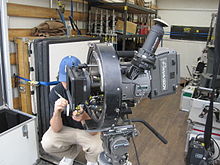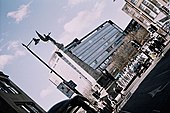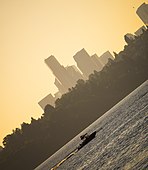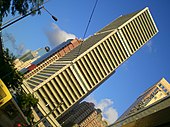Type of camera shot

In filmmaking and photography, the Dutch angle, also known as Dutch tilt, canted angle, or oblique angle, is a type of camera shot that involves setting the camera at an angle so that the shot is composed with vertical lines at an angle to the side of the frame, or so that the horizon line of the shot is not parallel with the bottom of the frame. This produces a viewpoint akin to tilting one's head to the side. In cinematography, the Dutch angle is one of many cinematic techniques often used to portray psychological uneasiness or tension in the subject being filmed. The Dutch angle is strongly associated with German expressionist cinema, which employed it extensively.
Etymology
The "Dutch" in "Dutch angle" is held by some to be a corruption of the German word Deutsch (meaning "German") due to the supposed popularity of the shot in silent-era German films. Alternatively, the adjective "Dutch" is thought to indicate something out of the ordinary (compare Dutch uncle, Dutch treat or Dutch auction) or, as in this case and the similarly named Dutch roll in aeronautics, something which is out of line.
The earliest recorded occurrences of the camera technique is to be found in the Edwin S. Porter American film Dream of a Rarebit Fiend (1906), itself based on Winsor McCay's comic strip of the same name, already known for its use of surrealist and oblique angles in its drawings.
Method

The Dutch angle is a shot in which the camera has been rotated around the axis of the lens and relative to the horizon or vertical lines in the shot.
The primary use of a Dutch angle is to cause a sense of unease or disorientation for the viewer. Dutch angles are often static shots, but in a dynamic (moving) Dutch angle shot, the camera can pivot, pan, or track along the established diagonal axis for the shot.
History
Dziga Vertov's 1929 experimental documentary Man with a Movie Camera contains uses of the Dutch angle, among other innovative techniques pioneered by Vertov.
The angle was widely used to depict madness, unrest, exoticism, and disorientation in German expressionist films. Montages of Dutch angles are often structured such that the tilts are horizontally opposed in each shot – for example, a right-tilted shot will be followed with a left-tilted shot, and so on.
In Hollywood's classic age, one filmmaker who used Dutch angles often was Alfred Hitchcock, whose early career included time at UFA studios in Germany; examples include Suspicion (1941), Notorious (1946), Strangers on a Train (1951) and The Man Who Knew Too Much (1956).
The 1949 film The Third Man makes extensive use of Dutch angle shots, to emphasize the main character's alienation in a foreign environment. Director Carol Reed has said that William Wyler gave him a spirit level after seeing the film, to sardonically encourage him to use more traditional shooting angles.
Dutch angles were used extensively in the 1960s Batman TV series and its 1966 film spin-off; each villain had his or her own angle, as they were "crooked".
Dutch angles are frequently used by film directors who have a background in the visual arts, such as Tim Burton (in Edward Scissorhands and Ed Wood), and Terry Gilliam (in Brazil, The Fisher King, 12 Monkeys, Fear and Loathing in Las Vegas and Tideland) to represent madness, disorientation, or drug psychosis. In his Evil Dead trilogy, Sam Raimi used Dutch angles to show that a character had become possessed by evil. In Rainer Werner Fassbinder’s Die Sehnsucht der Veronika Voss (1982), a Dutch angle is used to convey the odd tension that strangers are exerting on the main character.
Tom Hooper frequently uses dutch angles in his work in more creative ways and to reflect the time periods and settings of the stories, as seen in his work on Les Misérables (2012) and The King's Speech (2010). In the 2008 miniseries John Adams, Hooper uses dutch tilts to contrast the American scenes with the more traditional-looking cinematography of the scenes in France.
Power Rangers used Dutch angles frequently under former stunt coordinator and executive producer Koichi Sakamoto.
The Dutch angle is an overt cinematographical technique that can be overused. The science-fiction film Battlefield Earth (2000), in particular, drew sharp criticism for its pervasive use of the Dutch angle. In the words of film critic Roger Ebert: "the director, Roger Christian, has learned from better films that directors sometimes tilt their cameras, but he has not learned why".
Dutch angles are often used in horror video games, particularly those with static camera angles such as early entries in the Resident Evil and Silent Hill franchises. Similar to their use in movies, these angles are used to bring about a feeling of unease in the player.
Examples
See also
References
- ^ "Dutch angle – Hollywood Lexicon". Hollywood Lexicon. Archived from the original on 21 April 2023. Retrieved 14 March 2017.
- "Should You Use A Dutch Angle Shot in Your Films? (Answer: Yes, But...)". No Film School. 5 September 2015. Retrieved 5 August 2019.
- ^ Mamer, Bruce (2008). "Oblique Shot (Dutch Angle)". Film Production Technique: Creating the Accomplished Image. Belmont: Cengage Learning. pp. 9–10. ISBN 978-0-495-41116-1.
- Melvoin, J. (2023). Running the Show: Television from the Inside, pp. 282.
- Martin, C. (2024). Applied Screenwriting: How to Write True Scripts for Creative and Commercial Video, pp. 82.
- Revell, J. (2014). Exposure: From Snapshots to Great Shots, pp. 197.
- Pomerance, M. (2020). The Film Cheat: Screen Artifice and Viewing Pleasure, pp. 195.
- Mercado, G. (2013). The Filmmaker's Eye: Learning (and Breaking) the Rules of Cinematic Composition, pp. 101.
- Richard Meran Barsam: Looking at movies : an introduction to film, New York : W.W. Norton, 2004, pp. 212.
- Nashville Film Institute (10 October 2020). "Dutch Angle Shot: Everything You Need to Know". NFI. Retrieved 2 March 2021.
- Briselance, Marie-France; Morin, Jean-Claude (2010). Grammaire du cinéma. Paris, Nouveau Monde, 2010, 588 p. (ISBN 978-2-84736-458-3), p. 137-138.
- Dorn, Lori (20 April 2018). "How Subjective Use of the Dutch Angle Camera Technique Evokes Disorienting Doubt Within a Scene". Laughing Squid. Retrieved 5 August 2019.
- Bowen, Christopher J.; Thompson, Roy (2013). Grammar of the Shot. Taylor & Francis. p. 82. ISBN 978-0240526010. Retrieved 26 December 2014.
- Taplin, Phoebe; RBTH, special to (14 August 2014). "Dziga Vertov: Man with a movie camera". www.rbth.com. Retrieved 5 August 2019.
- ^ ScreenPrism (17 January 2016). "The Filmmaker's Handbook: What is a Dutch Tilt". The Take. Retrieved 2 February 2021.
- Charles Thomas Samuels, Encountering Directors, 1972 – interview with Carol Reed, excerpt at wellesnet.com
- Hooper, Tom (21 January 2011). "The King's Speech director Tom Hooper answers your questions – live!". guardian.co.uk (Guardian News & Media). Retrieved 6 July 2011 (archived by WebCite on 6 July 2011).
- ^ Ebert, Roger (12 May 2000). "Battlefield Earth". Chicago Sun-Times. Archived from the original on 2 October 2013. Retrieved 29 July 2006.
- ^ "They Call Me Spooky: The Spookiest Camera Angles in the Resident Evil Remake". Destructoid. October 2017. Retrieved 5 August 2019.
External links
 Media related to Dutch angle at Wikimedia Commons
Media related to Dutch angle at Wikimedia Commons
| Cinematic techniques | |||||||||||||||
|---|---|---|---|---|---|---|---|---|---|---|---|---|---|---|---|
| Lighting | |||||||||||||||
| Sound | |||||||||||||||
| Shooting |
| ||||||||||||||
|
| |||||||||||||||




